Abstract
Cryptosporidiosis, a diarrheal disease of calves and humans caused by the coccidian parasite Cryptosporidium parvum, is terminated in hosts with normal immune systems. To assess the mechanisms of immunity in cryptosporidiosis, it is necessary to isolate and quantitate sporozoites, the infective stage of Cryptosporidium spp. Here we report the (i) separation of infective C. parvum oocysts from calf feces by ether extraction, sieving, and hypochlorite treatment; (ii) separation of viable C. parvum sporozoites from intact and excysted oocysts by anion-exchange chromatography; and (iii) quantitation of sporozoite infectivity in vivo by direct intraintestinal injection of isolated sporozoites in 7-day-old BALB/c mice. When isolated sporozoites were incubated with heat-inactivated immune bovine serum, 25 times the 50% infective dose for 7-day-old mice was completely neutralized. Sporozoites incubated with preimmune bovine serum were infectious for 7-day-old mice.
Full text
PDF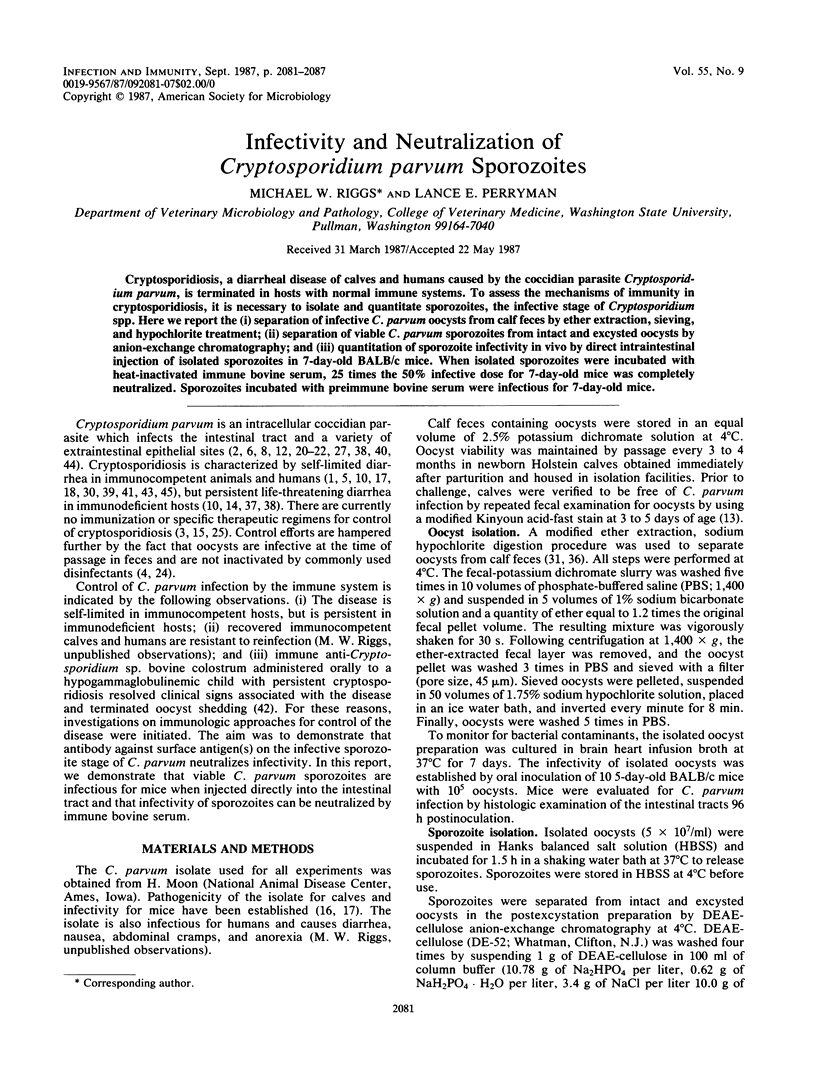
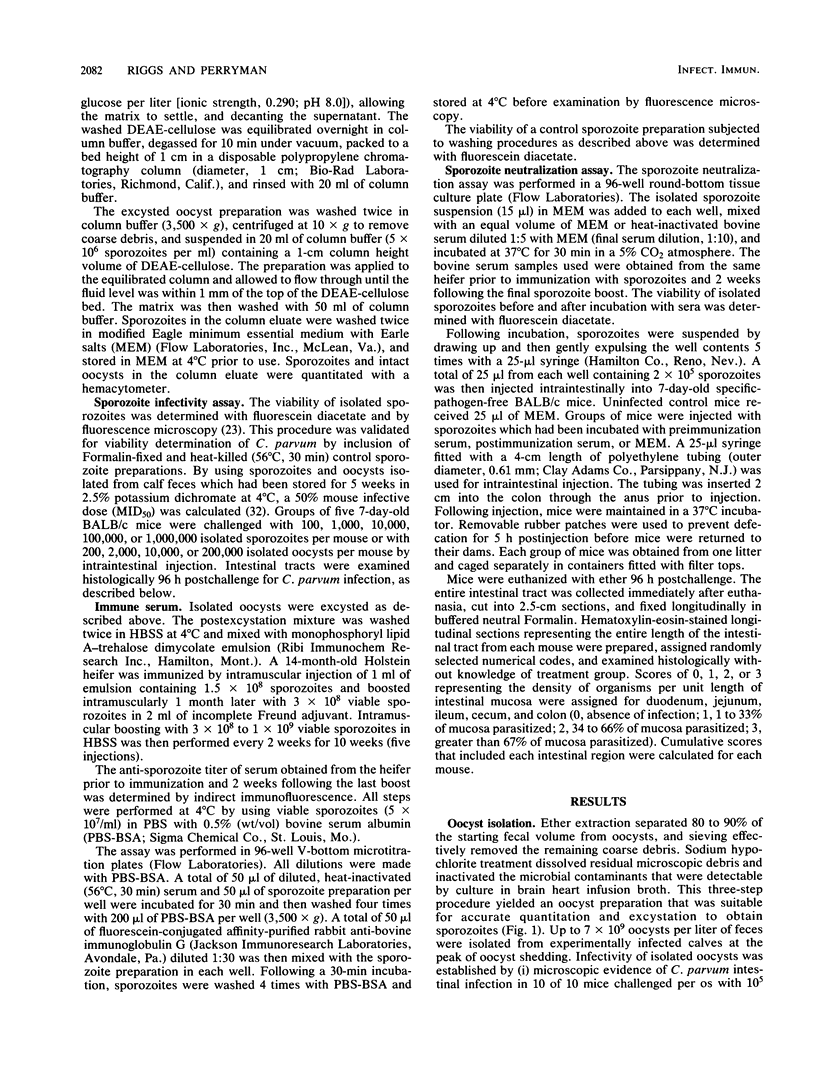
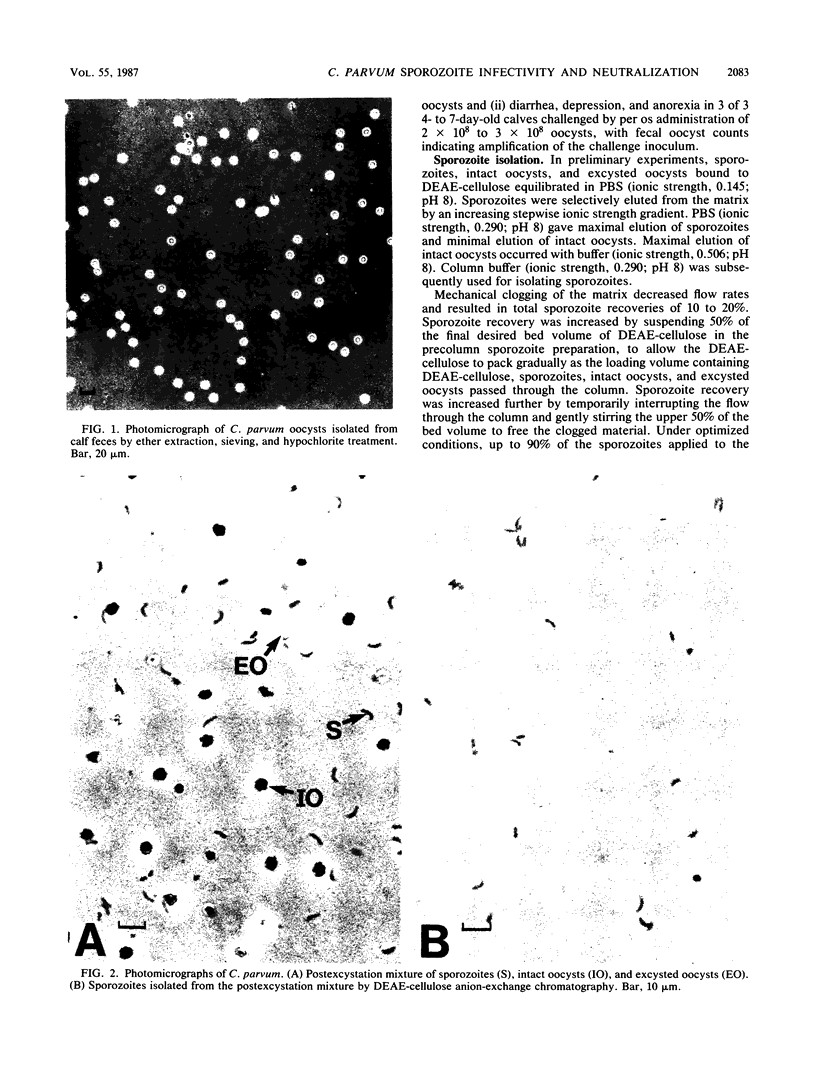
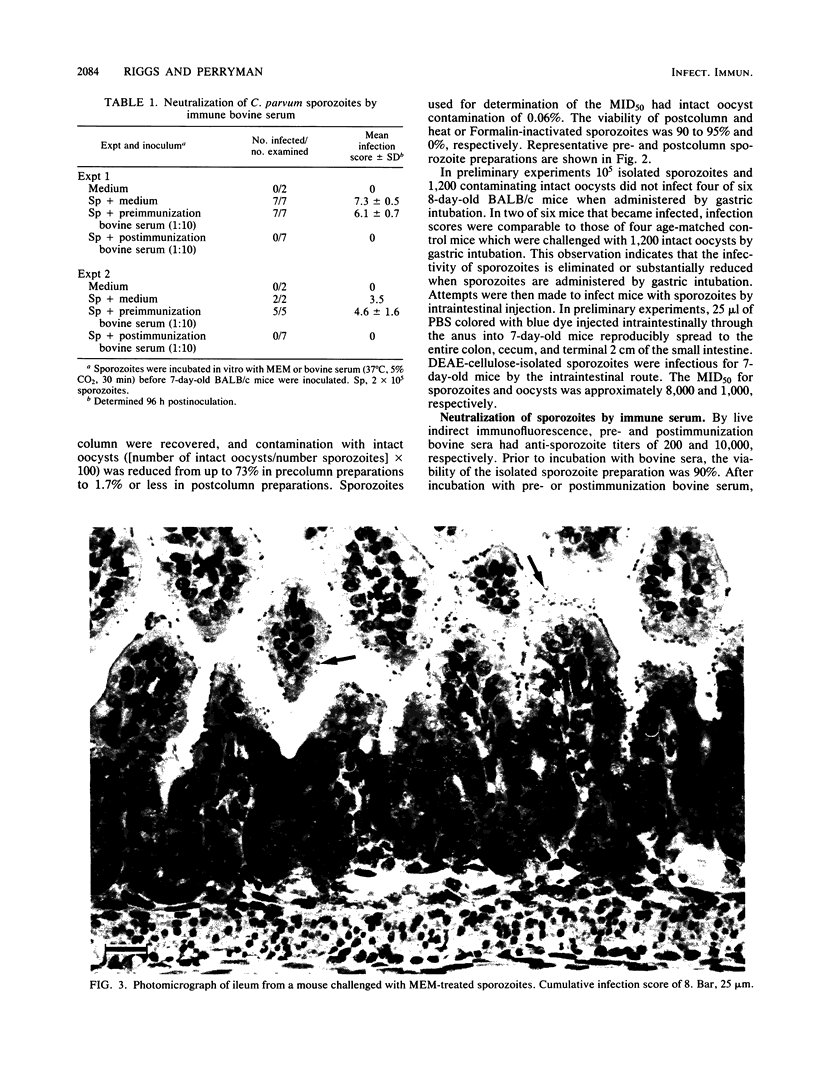
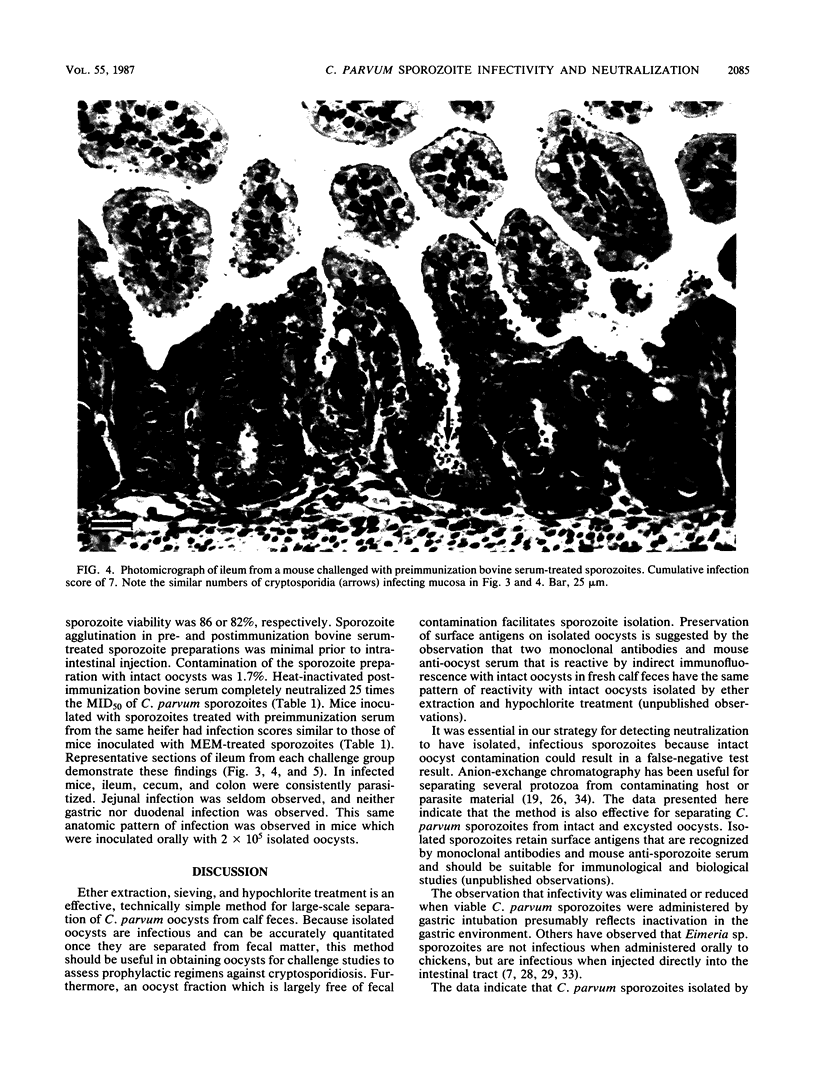
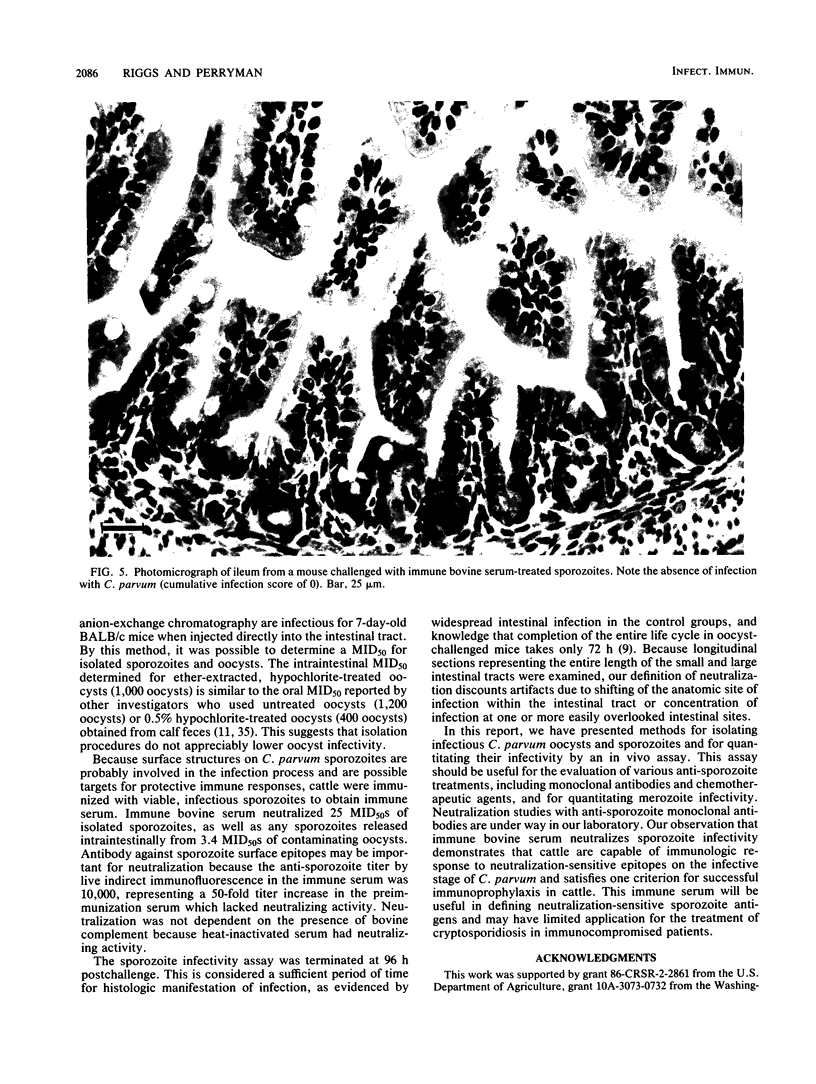
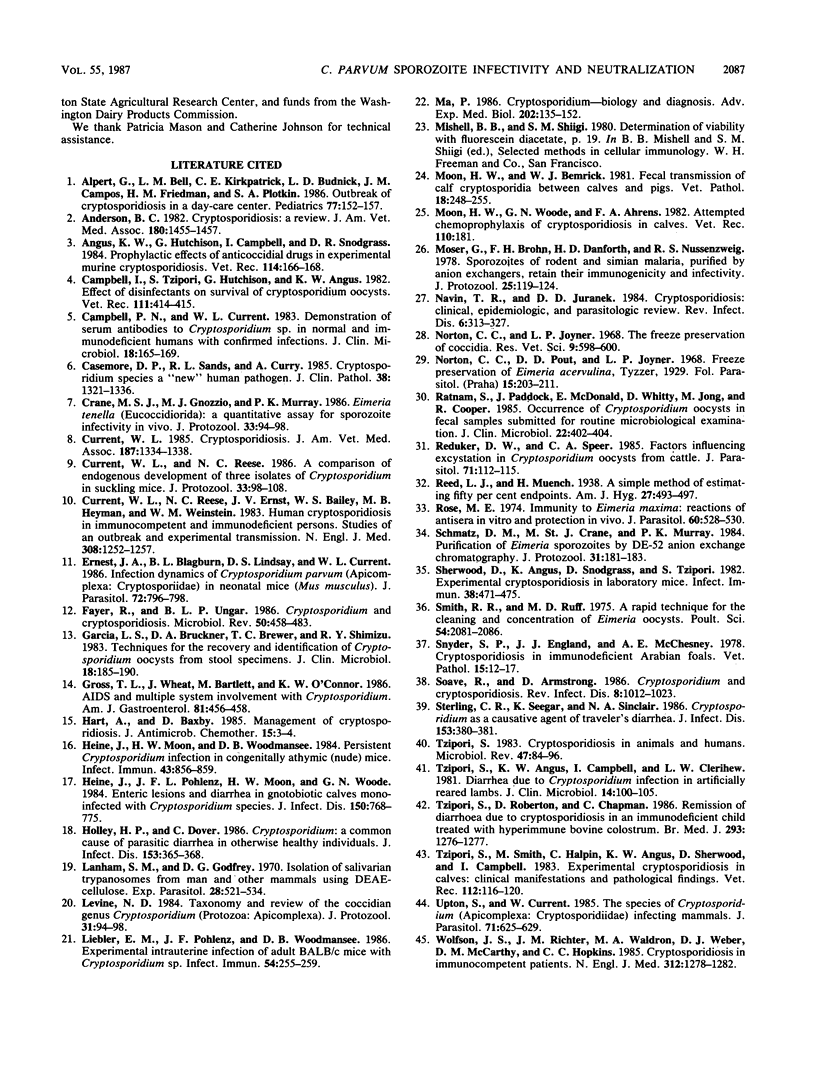
Images in this article
Selected References
These references are in PubMed. This may not be the complete list of references from this article.
- Alpert G., Bell L. M., Kirkpatrick C. E., Budnick L. D., Campos J. M., Friedman H. M., Plotkin S. A. Outbreak of cryptosporidiosis in a day-care center. Pediatrics. 1986 Feb;77(2):152–157. [PubMed] [Google Scholar]
- Anderson B. C. Cryptosporidiosis: a review. J Am Vet Med Assoc. 1982 Jun 15;180(12):1455–1457. [PubMed] [Google Scholar]
- Angus K. W., Hutchison G., Campbell I., Snodgrass D. R. Prophylactic effects of anticoccidial drugs in experimental murine cryptosporidiosis. Vet Rec. 1984 Feb 18;114(7):166–168. doi: 10.1136/vr.114.7.166. [DOI] [PubMed] [Google Scholar]
- Campbell I., Tzipori A. S., Hutchison G., Angus K. W. Effect of disinfectants on survival of cryptosporidium oocysts. Vet Rec. 1982 Oct 30;111(18):414–415. doi: 10.1136/vr.111.18.414. [DOI] [PubMed] [Google Scholar]
- Campbell P. N., Current W. L. Demonstration of serum antibodies to Cryptosporidium sp. in normal and immunodeficient humans with confirmed infections. J Clin Microbiol. 1983 Jul;18(1):165–169. doi: 10.1128/jcm.18.1.165-169.1983. [DOI] [PMC free article] [PubMed] [Google Scholar]
- Casemore D. P., Sands R. L., Curry A. Cryptosporidium species a "new" human pathogen. J Clin Pathol. 1985 Dec;38(12):1321–1336. doi: 10.1136/jcp.38.12.1321. [DOI] [PMC free article] [PubMed] [Google Scholar]
- Crane M. S., Gnozzio M. J., Murray P. K. Eimeria tenella (Eucoccidiorida): a quantitative assay for sporozoite infectivity in vivo. J Protozool. 1986 Feb;33(1):94–98. doi: 10.1111/j.1550-7408.1986.tb05566.x. [DOI] [PubMed] [Google Scholar]
- Current W. L. Cryptosporidiosis. J Am Vet Med Assoc. 1985 Dec 15;187(12):1334–1338. [PubMed] [Google Scholar]
- Current W. L., Reese N. C. A comparison of endogenous development of three isolates of Cryptosporidium in suckling mice. J Protozool. 1986 Feb;33(1):98–108. doi: 10.1111/j.1550-7408.1986.tb05567.x. [DOI] [PubMed] [Google Scholar]
- Current W. L., Reese N. C., Ernst J. V., Bailey W. S., Heyman M. B., Weinstein W. M. Human cryptosporidiosis in immunocompetent and immunodeficient persons. Studies of an outbreak and experimental transmission. N Engl J Med. 1983 May 26;308(21):1252–1257. doi: 10.1056/NEJM198305263082102. [DOI] [PubMed] [Google Scholar]
- Ernest J. A., Blagburn B. L., Lindsay D. S., Current W. L. Infection dynamics of Cryptosporidium parvum (Apicomplexa: Cryptosporiidae) in neonatal mice (Mus musculus). J Parasitol. 1986 Oct;72(5):796–798. [PubMed] [Google Scholar]
- Fayer R., Ungar B. L. Cryptosporidium spp. and cryptosporidiosis. Microbiol Rev. 1986 Dec;50(4):458–483. doi: 10.1128/mr.50.4.458-483.1986. [DOI] [PMC free article] [PubMed] [Google Scholar]
- Garcia L. S., Bruckner D. A., Brewer T. C., Shimizu R. Y. Techniques for the recovery and identification of Cryptosporidium oocysts from stool specimens. J Clin Microbiol. 1983 Jul;18(1):185–190. doi: 10.1128/jcm.18.1.185-190.1983. [DOI] [PMC free article] [PubMed] [Google Scholar]
- Gross T. L., Wheat J., Bartlett M., O'Connor K. W. AIDS and multiple system involvement with cryptosporidium. Am J Gastroenterol. 1986 Jun;81(6):456–458. [PubMed] [Google Scholar]
- Hart A., Baxby D. Management of cryptosporidiosis. J Antimicrob Chemother. 1985 Jan;15(1):3–4. doi: 10.1093/jac/15.1.3. [DOI] [PubMed] [Google Scholar]
- Heine J., Moon H. W., Woodmansee D. B. Persistent Cryptosporidium infection in congenitally athymic (nude) mice. Infect Immun. 1984 Mar;43(3):856–859. doi: 10.1128/iai.43.3.856-859.1984. [DOI] [PMC free article] [PubMed] [Google Scholar]
- Heine J., Pohlenz J. F., Moon H. W., Woode G. N. Enteric lesions and diarrhea in gnotobiotic calves monoinfected with Cryptosporidium species. J Infect Dis. 1984 Nov;150(5):768–775. doi: 10.1093/infdis/150.5.768. [DOI] [PMC free article] [PubMed] [Google Scholar]
- Holley H. P., Jr, Dover C. Cryptosporidium: a common cause of parasitic diarrhea in otherwise healthy individuals. J Infect Dis. 1986 Feb;153(2):365–368. doi: 10.1093/infdis/153.2.365. [DOI] [PubMed] [Google Scholar]
- Lanham S. M., Godfrey D. G. Isolation of salivarian trypanosomes from man and other mammals using DEAE-cellulose. Exp Parasitol. 1970 Dec;28(3):521–534. doi: 10.1016/0014-4894(70)90120-7. [DOI] [PubMed] [Google Scholar]
- Levine N. D. Taxonomy and review of the coccidian genus Cryptosporidium (protozoa, apicomplexa). J Protozool. 1984 Feb;31(1):94–98. doi: 10.1111/j.1550-7408.1984.tb04296.x. [DOI] [PubMed] [Google Scholar]
- Liebler E. M., Pohlenz J. F., Woodmansee D. B. Experimental intrauterine infection of adult BALB/c mice with Cryptosporidium sp. Infect Immun. 1986 Oct;54(1):255–259. doi: 10.1128/iai.54.1.255-259.1986. [DOI] [PMC free article] [PubMed] [Google Scholar]
- Ma P. Cryptosporidium--biology and diagnosis. Adv Exp Med Biol. 1986;202:135–152. doi: 10.1007/978-1-4684-1259-8_10. [DOI] [PubMed] [Google Scholar]
- Moon H. W., Bemrick W. J. Fecal transmission of calf cryptosporidia between calves and pigs. Vet Pathol. 1981 Mar;18(2):248–255. doi: 10.1177/030098588101800213. [DOI] [PubMed] [Google Scholar]
- Moon H. W., Woode G. N., Ahrens F. A. Attempted chemoprophylaxis of cryptosporidiosis in calves. Vet Rec. 1982 Feb 20;110(8):181–181. doi: 10.1136/vr.110.8.181-a. [DOI] [PubMed] [Google Scholar]
- Moser G., Brohn F. H., Danforth H. D., Nussenzweig R. S. Sporozoites of rodent and simian malaria, purified by anion exchangers, retain their immunogenicity and infectivity. J Protozool. 1978 Feb;25(1):119–124. doi: 10.1111/j.1550-7408.1978.tb03881.x. [DOI] [PubMed] [Google Scholar]
- Navin T. R., Juranek D. D. Cryptosporidiosis: clinical, epidemiologic, and parasitologic review. Rev Infect Dis. 1984 May-Jun;6(3):313–327. doi: 10.1093/clinids/6.3.313. [DOI] [PubMed] [Google Scholar]
- Norton C. C., Joyner L. P. The freeze preservation of coccidia. Res Vet Sci. 1968 Nov;9(6):598–600. [PubMed] [Google Scholar]
- Ratnam S., Paddock J., McDonald E., Whitty D., Jong M., Cooper R. Occurrence of Cryptosporidium oocysts in fecal samples submitted for routine microbiological examination. J Clin Microbiol. 1985 Sep;22(3):402–404. doi: 10.1128/jcm.22.3.402-404.1985. [DOI] [PMC free article] [PubMed] [Google Scholar]
- Reduker D. W., Speer C. A. Factors influencing excystation in Cryptosporidium oocysts from cattle. J Parasitol. 1985 Feb;71(1):112–115. [PubMed] [Google Scholar]
- Rose M. E. Immunity to Eimeria maxima: reactions of antisera in vitro and protection in vivo. J Parasitol. 1974 Jun;60(3):528–530. [PubMed] [Google Scholar]
- Schmatz D. M., Crane M. S., Murray P. K. Purification of Eimeria sporozoites by DE-52 anion exchange chromatography. J Protozool. 1984 Feb;31(1):181–183. doi: 10.1111/j.1550-7408.1984.tb04314.x. [DOI] [PubMed] [Google Scholar]
- Sherwood D., Angus K. W., Snodgrass D. R., Tzipori S. Experimental cryptosporidiosis in laboratory mice. Infect Immun. 1982 Nov;38(2):471–475. doi: 10.1128/iai.38.2.471-475.1982. [DOI] [PMC free article] [PubMed] [Google Scholar]
- Smith R. R., Ruff M. D. A rapid technique for the cleaning and concentration of Eimeria oocysts. Poult Sci. 1975 Nov;54(6):2081–2086. doi: 10.3382/ps.0542081. [DOI] [PubMed] [Google Scholar]
- Snyder S. P., England J. J., McChesney A. E. Cryptosporidiosis in immunodeficient Arabian foals. Vet Pathol. 1978 Jan;15(1):12–17. doi: 10.1177/030098587801500102. [DOI] [PubMed] [Google Scholar]
- Soave R., Armstrong D. Cryptosporidium and cryptosporidiosis. Rev Infect Dis. 1986 Nov-Dec;8(6):1012–1023. doi: 10.1093/clinids/8.6.1012. [DOI] [PubMed] [Google Scholar]
- Sterling C. R., Seegar K., Sinclair N. A. Cryptosporidium as a causative agent of traveler's diarrhea. J Infect Dis. 1986 Feb;153(2):380–381. doi: 10.1093/infdis/153.2.380. [DOI] [PubMed] [Google Scholar]
- Tzipori S., Angus K. W., Campbell I., Clerihew L. W. Diarrhea due to Cryptosporidium infection in artificially reared lambs. J Clin Microbiol. 1981 Jul;14(1):100–105. doi: 10.1128/jcm.14.1.100-105.1981. [DOI] [PMC free article] [PubMed] [Google Scholar]
- Tzipori S. Cryptosporidiosis in animals and humans. Microbiol Rev. 1983 Mar;47(1):84–96. doi: 10.1128/mr.47.1.84-96.1983. [DOI] [PMC free article] [PubMed] [Google Scholar]
- Tzipori S., Roberton D., Chapman C. Remission of diarrhoea due to cryptosporidiosis in an immunodeficient child treated with hyperimmune bovine colostrum. Br Med J (Clin Res Ed) 1986 Nov 15;293(6557):1276–1277. doi: 10.1136/bmj.293.6557.1276. [DOI] [PMC free article] [PubMed] [Google Scholar]
- Tzipori S., Smith M., Halpin C., Angus K. W., Sherwood D., Campbell I. Experimental cryptosporidiosis in calves: clinical manifestations and pathological findings. Vet Rec. 1983 Feb 5;112(6):116–120. doi: 10.1136/vr.112.6.116. [DOI] [PubMed] [Google Scholar]
- Upton S. J., Current W. L. The species of Cryptosporidium (Apicomplexa: Cryptosporidiidae) infecting mammals. J Parasitol. 1985 Oct;71(5):625–629. [PubMed] [Google Scholar]
- Wolfson J. S., Richter J. M., Waldron M. A., Weber D. J., McCarthy D. M., Hopkins C. C. Cryptosporidiosis in immunocompetent patients. N Engl J Med. 1985 May 16;312(20):1278–1282. doi: 10.1056/NEJM198505163122002. [DOI] [PubMed] [Google Scholar]







